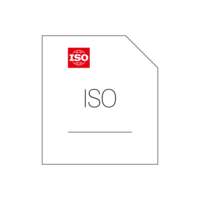

ISO/IEC 14496-10:2003
Ausgabedatum: 2003 11 27
Information technology — Coding of audio-visual objects — Part 10: Advanced Video Coding
ISO/IEC 14496-10:2003 was developed jointly with the ITU-T in response to the growing need for higher compression of moving pictures for various applications such as digital storage media, television broadcasting, Internet streaming and real-time audiovisual communication. It is also designed to enable the use of the coded video representation in a flexible manner for a wide variety of network environments. It is designed to be generic in the sense that it serves a wide range of applications, bit rates, resolutions, qualities and services. The use of ISO/IEC 14496-10:2003 allows motion video to be manipulated as a form of computer data and to be stored on various storage media, transmitted and received over existing and future networks and distributed on existing and future broadcasting channels. In the course of creating ISO/IEC 14496-10:2003, various requirements from typical applications have been considered, necessary algorithmic elements have been developed, and these have been integrated into a single syntax. Hence, ISO/IEC 14496-10:2003 will facilitate video data interchange among different applications.
The coded representation specified in the syntax is designed to enable a high compression capability for a desired image quality. The algorithm is not lossless, as the exact source sample values are typically not preserved through the encoding and decoding processes. A number of techniques are defined that may be used to achieve highly efficient compression. The expected encoding algorithm (not specified in ISO/IEC 14496-10:2003) selects between inter and intra coding for block-shaped regions of each picture. Inter coding uses motion vectors for block-based inter prediction to exploit temporal statistical dependencies between different pictures. Intra coding uses various spatial prediction modes to exploit spatial statistical dependencies in the source signal for a single picture. Motion vectors and intra prediction modes may be specified for a variety of block sizes in the picture. The prediction residual is then further compressed using a transform to remove spatial correlation inside the transform block before it is quantised, producing an irreversible process that typically discards less important visual information while forming a close approximation to the source samples. Finally, the motion vectors or intra prediction modes are combined with the quantised transform coefficient information and encoded using either variable length codes or arithmetic coding.
Annexes A through E contain normative requirements and are an integral part of ISO/IEC 14496-10:2003. Annex A defines three profiles (Baseline, Main and Extended), each being tailored to certain application domains, and defines the levels of capability within each profile. Annex B specifies syntax and semantics of a byte stream format for delivery of coded video as an ordered stream of bytes or bits. Annex C specifies the Hypothetical Reference Decoder and its use to check bitstream and decoder conformance. Annex D specifies syntax and semantics for Supplemental Enhancement Information message payloads. Annex E specifies syntax and semantics of the Video Usability Information parameters of the sequence parameter sets of coded video sequences.
